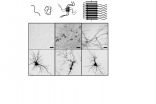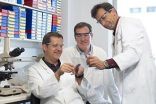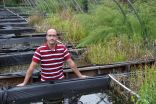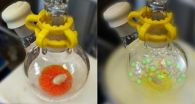What happens in our brain when we unlock a door?
A closer look at neural correlations when we use tools
2014-10-01
(Press-News.org) People who are unable to button up their jacket or who find it difficult to insert a key in lock suffer from a condition known as apraxia. This means that their motor skills have been impaired – as a result of a stroke, for instance. Scientists in Munich have now examined the parts of the brain that are responsible for planning and executing complex actions. They discovered that there is a specific network in the brain for using tools. Their findings have been published in the Journal of Neuroscience.
Researchers from Technische Universität München (TUM) and the Klinikum rechts der Isar hospital have analyzed the brain networks that control the use of tools or other utensils. Their chosen method of functional magnetic resonance imaging (fMRI) shows the areas of the brain that are activated when a person thinks, moves and performs actions.
The use of tools is an essential human skill. "Numerous studies are investigating the neural processes at play when we pick up a tool," says Prof. Joachim Hermsdörfer from TUM's Chair of Human Movement Science. "But many of these studies are restricted to test subjects observing an action, miming it, or simply visualizing it." The aim of this latest study was to analyze the basic neural principles of tool use under the most realistic conditions possible.
In the MRI study, the subjects received ten everyday objects, including a hammer, a bottle-opener, a key, a lighter and a scissors as well as some unfamiliar objects. Their task was to either use the objects or simply lift them up and place them down again, first with the left and then with the right hand. When they analyzed the data, the scientists looked at the planning phase and the actual execution phase separately. In this way, they were able to identify the brain networks that were activated while the subjects planned and used a tool and those that controlled execution.
Tool-Specific Network in the Brain
One important finding was that the left hemisphere was activated when the subjects planned to use a tool – regardless of the hand they held it in. In addition, the researchers recognized a distributed network responsible for both planning and execution. When working with unfamiliar objects, these regions of the brain were less activated.
The "tool network" consists of brain regions of the parietal and frontal lobes as well as regions in the posterior temporal lobe and another area in the lateral occipital lobe. What the researchers found, therefore, was a neural activation pattern that covered all elements of a complex action. This includes recognizing the objects as tools, understanding how they are used, and the motor action to actually use the tool.
"The study also allowed us to confirm that there are different streams of perception in the brain for different tasks," explains Hermsdörfer. The dorsal stream of perception conducts signals to the posterior parietal lobe and is generally responsible for controlling actions. "It can be divided into two function-specific processing pathways. The dorso-dorsal stream controls basic gripping and movement processes, regardless of whether the person is familiar with the object or not. A second ventro-dorsal stream becomes active when we use tools that are familiar to us.
Armed with knowledge about the localization of these "action modules", doctors could in future provide a more differentiated diagnosis of apraxia and develop improved therapeutic approaches.
INFORMATION:
Publication
Brandi M-L, Wohlschläger A, Sorg C, Hermsdörfer J. The Neural Correlates of Planning and Executing Actual Tool Use, Journal of Neuroscience, 34(39):13183-13194
DOI: 101523/JNEUROSCI.0597-14.2014
[Attachments] See images for this press release:
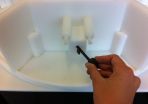
ELSE PRESS RELEASES FROM THIS DATE:
2014-10-01
Researchers have discovered a new type of brain activity that underlies the timing of voluntary actions, allowing them to forecast when a spontaneous decision will occur more than a second in advance. 'Experiments like this have been used to argue that free will is an illusion, but we think that this interpretation is mistaken,' says Zachary Mainen, a neuroscientist at the Champalimaud Centre for the Unknown, in Lisbon, Portugal, who led the research, published on Sept. 28, 2014, in the journal Nature Neuroscience.
The scientists used recordings of neurons in an area ...
2014-10-01
The peptide —a small protein— beta-amyloid is strongly associated with Alzheimer's disease; however, researchers are still looking for unequivocal proof that this peptide is the causal agent of the onset and development of the disease. The main obstacle impeding such confirmation is that beta-amyloid is not harmful when found in isolation but only when it aggregates, that is when it self-assembles to form the so-called amyloid fibrils
"We are not dealing with a single target, beta-amyloid alone, but with multiple ones because each aggregate of peptide, which can go from ...
2014-10-01
Current changes in the ocean around Antarctica are disturbingly close to conditions 14,000 years ago that new research shows may have led to the rapid melting of Antarctic ice and an abrupt 3-4 metre rise in global sea level.
The research published in Nature Communications found that in the past, when ocean temperatures around Antarctica became more layered - with a warm layer of water below a cold surface layer - ice sheets and glaciers melted much faster than when the cool and warm layers mixed more easily.
This defined layering of temperatures is exactly what is ...
2014-10-01
An international team of scientists has shown that more than 80 per cent of bowel cancers could be treated with existing drugs.
The study found that medicines called 'JAK inhibitors' halted tumour growth in bowel cancers with a genetic mutation that is present in more than 80 per cent of bowel cancers. Multiple JAK inhibitors are currently used, or are in clinical trials, for diseases including rheumatoid arthritis, psoriasis, blood cancers and myeloproliferative disorders.
Bowel cancer is the second-most common cancer in Australia with nearly 17,000 people diagnosed ...
2014-10-01
DURHAM, N.C. -- A Duke University team has found that nanoparticles called single-walled carbon nanotubes accumulate quickly in the bottom sediments of an experimental wetland setting, an action they say could indirectly damage the aquatic food chain.
The results indicate little risk to humans ingesting the particles through drinking water, say scientists at Duke's Center for the Environmental Implications of Nanotechnology (CEINT). But the researchers warn that, based on their previous research, the tendency for the nanotubes to accumulate in sediment could indirectly ...
2014-10-01
Computer modelling of the human eye, the brain of a rat and a robot could revolutionise advances in neuroscience and new technology, says a QUT leading robotics researcher.
Dr Michael Milford from QUT's Science and Engineering Faculty says the new study uses new computer algorithms to enable robots to navigate intelligently, unrestricted by high-density buildings or tunnels.
"This is a very Frankenstein type of project," Dr Milford said.
"It's putting two halves of a thing together because we're taking the eyes of a human and linking them up with the brain of a rat.
"A ...
2014-10-01
An international group of researchers led by Dr. Warren E. Piers (University of Calgary) and Dr. Heikki M. Tuononen (University of Jyväskylä) has been able to isolate and characterize an important chemical intermediate whose existence has, so far, only been inferred from indirect experimental evidence.
Chemical reactions rarely go from starting materials to final products in one single step, but instead they progress through a number of intermediates. In many cases the intermediates are not stable enough to be studied by conventional characterization methods, which thwarts ...
2014-10-01
Philadelphia, PA, October 1, 2014 – Patients with increased inflammation, including those receiving cytokines for medical treatment, have a greatly increased risk of depression. For example, a 6-month treatment course of interferon-alpha therapy for chronic hepatitis C virus infection causes depression in approximately 30% of patients.
Omega-3 fatty acids, more commonly known as fish oil, have a long list of health benefits, including lowering the risk of heart disease and reducing triglyceride levels. These nutritional compounds are also known to have anti-depressant ...
2014-10-01
When appointing a new leader, selectors base their choice on several factors and typically look for leaders with desirable characteristics such as honesty and trustworthiness. However once leaders are in power, can we trust them to exercise it in a prosocial manner?
New research published in The Leadership Quarterly looked to discover whether power corrupts leaders. Study author John Antonakis and his colleagues from the University of Lausanne explain, "We looked to examine what Lord Acton said over 100 years ago, that 'Power corrupts and absolute power corrupts absolutely.'"
To ...
2014-10-01
Chicago, October 1, 2014 – Patients receiving lungs from donors whose cause of death was asphyxiation or drowning have similar outcomes and long-term survival as patients receiving lungs from traditional donors, according to a study in the October2014 issue of the Annals of Thoracic Surgery.
Key points:
Lungs from donors whose cause of death was asphyxiation or drowning can be safely transplanted into patients with end-stage lung disease.
Patient survival rates were not affected when lungs from cases involving asphyxiation and drowning were used.
The researchers note ...
LAST 30 PRESS RELEASES:
[Press-News.org] What happens in our brain when we unlock a door?
A closer look at neural correlations when we use tools

